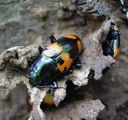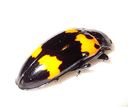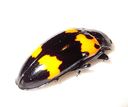Encaustini
Encaustini
Classification
- Phylum: Arthropoda
- Subphylum: Hexapoda
- Class: Insecta
- Order: Coleoptera
- Suborder: Polyphaga
- Superfamily: Cucujoidea
- Family: Erotylidae
- Subfamily: Erotylinae
- Tribe: Encaustini
Pronunciation
How to pronounce Encaustini: /ˌɛnkaʊsˈtɪnaɪ/
These audio files are automatically generated. While they are not always 100% accurate, they are a good starting point.
Images






Summary
The tribe Encaustini consists of a single genus with two species in North America, primarily feeding on bracket fungi. They exhibit gregarious behavior under bark and are nocturnally active. Their larvae require 2-3 months to mature, with adults overwintering.
Physical Characteristics
Adults are often gregarious under bark and are nocturnally active.
Habitat
Under bark of trees where bracket fungi are present.
Distribution
North America.
Diet
Feed on bracket fungi.
Life Cycle
Larvae take 2-3 months to mature; undergo a life cycle that includes overwintering as adults.
Ecosystem Role
Play a role in the decomposition of wood and fungi.
Tags
- Encaustini
- Coleoptera
- Bracket fungi